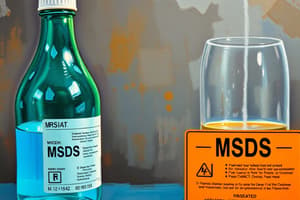Podcast
Questions and Answers
Which type of data hazard occurs when an instruction tries to read an operand before another instruction writes it?
Which type of data hazard occurs when an instruction tries to read an operand before another instruction writes it?
- a. RAW hazard (correct)
- d. RAR hazard
- b. WAR hazard
- c. WAW hazard
Regarding pipelining in microprocessors, which one of the following is true?
Regarding pipelining in microprocessors, which one of the following is true?
- b. Pipelining improves the throughput of a program. (correct)
- a. Pipelining reduces the latency of a single instruction.
- d. Pipelining reduces the number of instructions executed per cycle.
- c. Pipelining increases the clock speed of the processor.
What is the meaning of the acronym 'RAW' in the context of data hazards?
What is the meaning of the acronym 'RAW' in the context of data hazards?
- a. Read After Write (correct)
- c. Write After Write
- b. Write After Read
- d. Read After Read
In the context of data hazards, what does 'WAW' stand for?
In the context of data hazards, what does 'WAW' stand for?
Which one of the following is not a true statement regarding pipelining in microprocessors?
Which one of the following is not a true statement regarding pipelining in microprocessors?
Which stage of a RISC instruction pipeline fetches the next instruction from memory?
Which stage of a RISC instruction pipeline fetches the next instruction from memory?
What is the purpose of the Execute (EX) stage in a RISC instruction pipeline?
What is the purpose of the Execute (EX) stage in a RISC instruction pipeline?
Which technique is used in a RISC instruction pipeline to enhance the performance of a CPU?
Which technique is used in a RISC instruction pipeline to enhance the performance of a CPU?
What are the typical stages in a RISC instruction pipeline?
What are the typical stages in a RISC instruction pipeline?
What is the purpose of the Memory (MEM) stage in a RISC instruction pipeline?
What is the purpose of the Memory (MEM) stage in a RISC instruction pipeline?
Study Notes
Data Hazards in Pipelining
- A Read-After-Write (RAW) data hazard occurs when an instruction tries to read an operand before another instruction writes it.
Pipelining in Microprocessors
- The acronym 'RAW' in the context of data hazards stands for Read-After-Write.
- 'WAW' stands for Write-After-Write in the context of data hazards.
- One of the false statements regarding pipelining in microprocessors is not given in the text.
RISC Instruction Pipeline
- The Fetch (FE) stage in a RISC instruction pipeline fetches the next instruction from memory.
- The purpose of the Execute (EX) stage is to execute the instruction.
- The technique used to enhance CPU performance in a RISC instruction pipeline is pipelining.
- The typical stages in a RISC instruction pipeline are Fetch (FE), Decode (DE), Execute (EX), Memory (MEM), and Write Back (WB).
- The purpose of the Memory (MEM) stage is to access memory, either to load data or to store results.
Studying That Suits You
Use AI to generate personalized quizzes and flashcards to suit your learning preferences.
Description
Test your knowledge on data hazards in computer architecture with this quiz from the Indian Institute of Technology Guwahati. Learn about different types of data hazards and improve your understanding of multi-core computer architecture.




